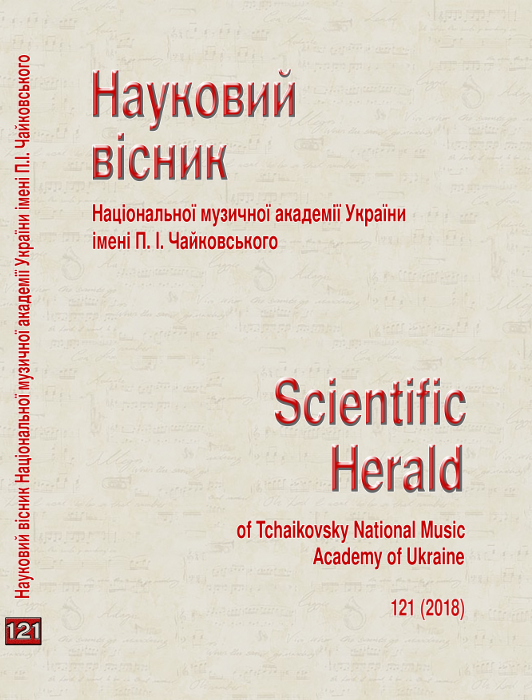Singing at the Lviv Epiphany Church (from the origins to the end of the 18th century)
DOI:
https://doi.org/10.31318/2522-4190.2018.121.133194Keywords:
cantus fractus, Irmologion, kolyadka, singers, conductors, parishionersAbstract
The history of church singing of any particular temple should be started from the time of the first divine service held in it. Another thing is that such service is not always accompanied by documentary evidence. One of such "silent" churches until recently was the Lviv Epiphany Church, but thanks to the diligent and thorough work of the Ukrainian historian Myron Kapral', there was an opportunity to explore the musical aspect of its activities through documents. The importance of this article is that it demonstrates a typical musical practice in the peripheral Ukrainian church of the early modern era.
The purpose of the study is to collect and analyze documents and other written sources concerning singing practices in the church. All available sources are investigated for the first time.
Results and conclusions. It was discovered that in the 1650s, polyphony singing was already practiced in this church. In the early 1700s, the printed and hand-written linear (modern staff notation) Irmologions were kept in the church. In addition, among the documents of the brotherhood, has been preserved the manuscript with the verbal text of the Christmas carol (kolyadka) Raduytesya vsi lyudiye, dated by 1705. This list of carols is the oldest among Ukrainian sources. Thanks to the Book of Expenditures (1705-1791) of the Lviv Epiphany Brotherhood, we have information about singers and conductors of the church. Also, from the expenditure documents of the brotherhood, we can draw some information about several Lviv musicians, probably parishioners of the church.
Downloads
References
Aleksandrovych, V. (2015). L`vivs`ky`j oseredok ukrayins`ky`x malyariv drugoyi polovy`ny` XVII stolittya [Lviv center of the Ukrainian painters of the second half of the 17th century]. In: Z istoriyi zaxidnoukrayins`ky`x zemel`. L`viv. Vy`p. 10–11, pp. 37–70 [in Ukrainian].
(1904). Arhiv Yugo-Zapadnoy Rossii, izdavaemyiy vremennoy komissiey dlya razbora drevnih aktov, sostoyaschey pri KIevskom', Podolskom' i Volyinskom' General'-Gubernatore. Aktyi, otnosyaschIesya k' istorIi Galitsko-russkoy pravoslavnoy tserkvi (1423–1714 gg.) [Archive of South-West Russia, published by the provisional commission for the analysis of ancient acts, which is administered by the Governor of Kyiv, Podolye and Volhynia. Acts relating to the history of the Galician-Russian Orthodox Church (1423–1714)]. Кiev. Part one. Vol. 10, 28+967 p. [in Russian].
(2000). Barokovi dukhovni pisni z rukopysnykh spivanykiv XVIII st. Lemkivshchyny [Baroque spiritual songs from the manuscript compilations of the XVIII century from Lemkivshchyna]. Vstup, uporyad. i koment. O. Hnatyuk. L'viv : Misioner, 336 p. [in Ukrainian].
Zosim, O. (2009). Zakhidnoyevropeys'ka dukhovna pisnya na skhidnoslov"yans'kykh zemlyakh u XVII–XIX stolittyakh [Western European spiritual song in the East Slavic lands in the 17th-19th centuries]. Kyiv : NAKKKiM, 204 p. [in Ukrainian].
Kapral', M. (2016). Bohoyavlens'ke bratstvo L'vova u XVIII st. : doslidzhennya ta materialy [Epiphany Brotherhood of Lviv in the 18th century: research and materials]. L'viv : Literaturna ahentsiya «Piramida». XCV+328 p. [in Ukrainian].
L'vivs'kyy istorychnyy muzey. Viddil fondiv (dokumenty) [Lviv Historical Museum. Department of funds (documents)], spr. 122.
Natsional'na biblioteka Ukrayiny imeni V. I. Vernads'koho [Vernadsky National Library of Ukraine], f. Maslova, No 48.
(2015). Partesna muzyka Peremys'koyi yeparkhiyi : Rukopysni uryvky seredyny XVII – pochatku XVIII stolittya [Partes music of the Diocese of Przemyśl: manuscript excerpts from the middle of the 17th – early 18th centuries]. Uporyadnyky, vstupne slovo V. Pylypovych, Yu. Yasinovs'kyy; identyfikatsiya uryvkiv, rekonstruktsiya partytury, peredmova O. Shumilina [Pam‘yatky sakral'noyi muzyky Peremys'koyi yeparkhiyi, t. 3]. Peremyshl', 258 p. [in Ukrainian].
Rossiyskaya gosudarstvennaya biblioteka [Russian State Library], f. 173, No 107. 10.Rossiyskaya natsionalnaya biblioteka [Russian National Library], f. Titova, No 4172.
Solovij, M, Vely`ky`j, A. (1967). Svyaty`j Josafat Kuncevy`ch: jogo zhy`ttya i doba. Toronto : Vy`davny`cztvo oo Vasy`liyan, 326 p. [in Ukrainian].
Yasinovs'kyy, Yu. (2002). L'vivs'ki notni pershodruky [Lviv's first printed musical notes]. In: KALOFONIYA. Naukovyy zbirnyk z istoriyi tserkovnoyi monodiyi ta hymnohrafiy. Chyslo 1, pp. 25–36. [in Ukrainian].
Kuzminsky, I. (2012). Joint and Divergent Elements in the Vilnius Treatises of the Second Half of the 17th Century: Musical Grammar by Mykola Dyletsky and Ars et Praxis Musica by Sigismundus Lauxmin. In: Lietuvos muzikologija. T. 13, pp. 103–117 [in English].
Liauksminas, Ž. (1977). Ars et praxis musica (Parengė Vytautas Jurkštas). Vilnius: Vaga, 480 p. [in Lithuanian].
Downloads
Published
How to Cite
Issue
Section
License
Our journal abides by the CREATIVE COMMONS copyright rights and permissions for open access journals.
Authors, who are published in this journal, agree to the following conditions:
The authors reserve the right to authorship of the work and pass the first publication right of this work to the journal under the terms of a Creative Commons Attribution License, which allows others to freely distribute the published research with the obligatory reference to the authors of the original work and the first publication of the work in this journal.
The authors have the right to conclude separate supplement agreements that relate to non-exclusive work distribution in the form in which it has been published by the journal (for example, to upload the work to the online storage of the journal or publish it as part of a monograph), provided that the reference to the first publication of the work in this journal is included.




